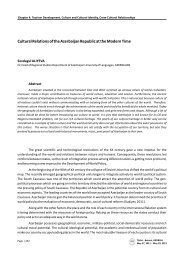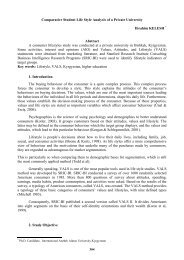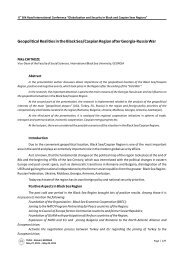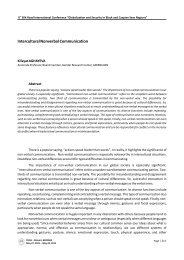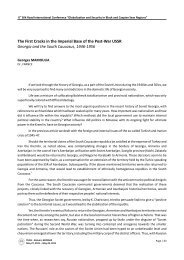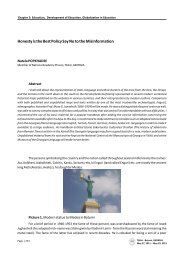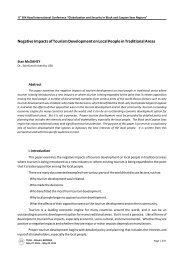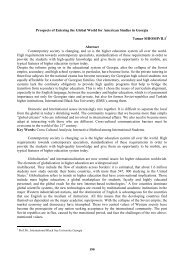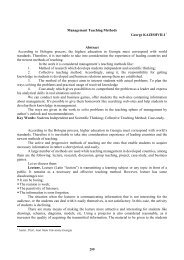Aygul ISAYEVA, The Role of Loyalty Phases as a Moderator of the ...
Aygul ISAYEVA, The Role of Loyalty Phases as a Moderator of the ...
Aygul ISAYEVA, The Role of Loyalty Phases as a Moderator of the ...
You also want an ePaper? Increase the reach of your titles
YUMPU automatically turns print PDFs into web optimized ePapers that Google loves.
Chapter 3: Globalization and Economics, Business and Globalization, Business Management and Services<br />
<strong>The</strong> <strong>Role</strong> <strong>of</strong> <strong>Loyalty</strong> <strong>Ph<strong>as</strong>es</strong> <strong>as</strong> a <strong>Moderator</strong> <strong>of</strong> <strong>the</strong> Relationship between<br />
Satisfaction with Service Recovery and its Drivers<br />
<strong>Aygul</strong> <strong>ISAYEVA</strong><br />
Marketing Manager at SOCAR Georgia Petroleum, Invited lecturer at International Black Sea University, Georgia<br />
Abstract<br />
Service failures are inevitable. Customers tend not to complain when <strong>the</strong>y happen. Given that we are able to make<br />
customers complain, what actions should we take? We know what <strong>the</strong> drivers <strong>of</strong> satisfaction with service recovery are, but<br />
we do not know if <strong>the</strong>y are <strong>of</strong> equal importance to all customers. Most likely not. I think <strong>the</strong> loyalty ph<strong>as</strong>e <strong>the</strong> customer is in<br />
effects <strong>the</strong> relationship between satisfaction with service recovery and its drivers. My preliminary findings support <strong>the</strong><br />
hypo<strong>the</strong>ses. <strong>Loyalty</strong> ph<strong>as</strong>es seem to moderate <strong>the</strong> relationship between satisfaction with service recovery and its drivers.<br />
Keywords: Customer Satisfaction with Service Recovery, <strong>Loyalty</strong> ph<strong>as</strong>es, Customer Complaint Behavior,<br />
Disconfirmation, Distributive Justice, Procedural Justice, Interactional justice<br />
Introduction<br />
Very few customers complain despite having experienced service failure (Stephens and Gwinner<br />
1998). <strong>The</strong> re<strong>as</strong>ons for not complaining are plentiful (Vorhees, Brady and Horowitz 2006) and <strong>the</strong><br />
consequences potentially dev<strong>as</strong>tating to a company resulting in incre<strong>as</strong>ed “opportunity cost” (Fornell and<br />
Wernfelt 1987 and Vorhees, Brady and Horowitz 2006), lost market share and declining pr<strong>of</strong>itability (e.g.<br />
Estelami 2000). On <strong>the</strong> o<strong>the</strong>r hand if <strong>the</strong> customer complains it should be considered <strong>as</strong> a gift (Barlow and<br />
Moeller 1996) and listened carefully in order to take <strong>the</strong> right corrective actions turning <strong>the</strong> unhappy customers<br />
into delighted apostles singing our gospel. Leaning me on <strong>the</strong> logic <strong>of</strong> <strong>the</strong> service recovery paradox, this should<br />
be a possibility at le<strong>as</strong>t <strong>the</strong>oretically. Still, <strong>the</strong> support for such effects is mixed and seems to depend on<br />
situational factors such <strong>as</strong> <strong>the</strong> cause and severity <strong>of</strong> <strong>the</strong> failure and whe<strong>the</strong>r <strong>the</strong> company had control over <strong>the</strong><br />
failure (Magnini, Ford, Markowski and Honeycutt (2007). Lowering my ambitions concerning customer<br />
satisfaction and loyalty after a service failure to a more realistic level, <strong>the</strong>re are still many potential benefits to<br />
collect. To mention but a few, complaint handling provides information to improve products/services, positive<br />
customer attitudes, incre<strong>as</strong>ed repurch<strong>as</strong>e intentions, positive word-<strong>of</strong>-mouth and communication about <strong>the</strong><br />
provider (Stauss and Seidel 2004, Stauss and Schoeler 2004). Lately, Luo and Homburg (2008) have even found<br />
that complaint handling h<strong>as</strong> a stronger effect on stock value gap than customer satisfaction. Also, an efficient<br />
service recovery should prevent double deviations situations, i.e. inappropriate or inadequate response to a<br />
failure (Johnston and Fern 1999) turning a bad situation into an even worse one. In order to develop efficient<br />
service recovery systems, collect <strong>the</strong> benefits and avoid double deviation situations, I need to understand <strong>the</strong><br />
customer's situation. From earlier work it is known that personal and situational factors have an impact on<br />
customers' <strong>as</strong>sessments <strong>of</strong> service delivery and <strong>the</strong>ir level <strong>of</strong> satisfaction (e.g. Wilson, Zeithaml, Bitner and<br />
Gremler 2008). Also, customers engage in different types <strong>of</strong> relationships with service providers (Gutek, Cherry,<br />
Page | 154<br />
Tbilisi - Batumi, GEORGIA<br />
May 27, 2011 – May 29, 2011
th<br />
6 Silk Road International Conference “Globalization and Security in Black and C<strong>as</strong>pian Se<strong>as</strong> Regions”<br />
Bhappu, Schneider and Woolf 2000), like for instance service encounters, pseudo relationship or true<br />
relationships (Gutek, Cherry, Bhappu, Schneider and Woolf 2000) or <strong>the</strong>y are acquaintances, friends or<br />
partners with <strong>the</strong> service provider (Johnson and Selnes 2004). <strong>The</strong>se different relationships are compounded<br />
by different dimensions and <strong>the</strong> relationship between customer satisfaction and loyalty vary depending on <strong>the</strong><br />
loyalty ph<strong>as</strong>e <strong>the</strong> customer is in i.e. cognitive, affective, conative or action loyalty (Oliver 1999). One <strong>of</strong> <strong>the</strong> first<br />
studies to investigate <strong>the</strong> effects <strong>of</strong> complaint handling on customer relationships w<strong>as</strong> conducted by Tax, Brown<br />
and Chandr<strong>as</strong>hekaran (1998). <strong>The</strong>y looked at how <strong>the</strong> interplay between satisfaction with complaint handling<br />
and previous experience affect trust and commitment. While Mattila (2001) studied how relationship type<br />
impacts customer loyalty in <strong>the</strong> context <strong>of</strong> service failure. Some few studies have been carried out to test<br />
Oliver's (1997, 1999) loyalty ph<strong>as</strong>es empirically (Evanschitzky and Wunderlich 2006, Harris and Goode 2004<br />
and Sivad<strong>as</strong> and Baker-Prewitt 2000) <strong>as</strong> well. But, to <strong>the</strong> best <strong>of</strong> my knowledge and despite its relevance, none<br />
h<strong>as</strong> tested this framework in <strong>the</strong> context <strong>of</strong> complaint handling or service recovery. As such <strong>the</strong> purpose <strong>of</strong> my<br />
study is to investigate how loyalty ph<strong>as</strong>es may affect <strong>the</strong> relationship between satisfaction with service<br />
recovery and its drivers. Hence <strong>the</strong> research question is:<br />
To what extent do <strong>the</strong> loyalty ph<strong>as</strong>es moderate <strong>the</strong> relationship between customer satisfaction with<br />
service recovery and its drivers?<br />
In this article I will first present a brief literature review and develop hypo<strong>the</strong>ses. I describe my method<br />
<strong>of</strong> collecting data and present some preliminary findings from testing <strong>the</strong> hypo<strong>the</strong>ses and <strong>the</strong> conceptual<br />
model. <strong>The</strong>se early results are discussed briefly along with how <strong>the</strong> analysis can be preceded most efficiently.<br />
Service Recovery Satisfaction<br />
<strong>The</strong> antecedents<br />
<strong>The</strong> drivers <strong>of</strong> satisfaction with service recovery are well established. Andre<strong>as</strong>sen (2000), Olsen and<br />
Johnson, McCollough, Berry and Yadav (2000), Smith, Bolton and Wagner (1999), Tax, Brown and<br />
Chandr<strong>as</strong>hekaran (1998), all find support for justice or perceived customer equity <strong>as</strong> an important driver <strong>of</strong><br />
satisfaction with service recovery. In several <strong>of</strong> <strong>the</strong>se studies customer perceived equity or justice are<br />
operationalized and me<strong>as</strong>ured in terms <strong>of</strong> distributive, procedural and interactional justice (e.g. Smith, Bolton<br />
and Wagner 1999, Tax, Brown and Chandr<strong>as</strong>hekaran 1998). Although it seems like <strong>the</strong>se dimensions are all<br />
important in influencing satisfaction with service recovery, <strong>the</strong>y may play different roles with different effects.<br />
For instance Blodgett, Hill and Tax (1997) found that interactional justice can compensate for lower levels <strong>of</strong><br />
distributive justice in creating satisfaction. Both Andre<strong>as</strong>sen (2000) and Smith, Bolton and Wagner (1999)<br />
added disconfirmation <strong>of</strong> expectations toward service recovery <strong>as</strong> an antecedents to satisfaction with service<br />
recovery and found support in <strong>the</strong>ir data sets. Andre<strong>as</strong>sen (2000) also included initial negative affect <strong>as</strong> a<br />
potential driver <strong>of</strong> satisfaction with service recovery, but did not find any significant effects or support for this <strong>as</strong><br />
an antecedent. Schoefer (2008) on <strong>the</strong> o<strong>the</strong>r hand suggests that satisfaction with service recovery is b<strong>as</strong>ed<br />
partly on cognitive e.g. justice and partly on affective responses. Schoefer found support for <strong>the</strong> proposed<br />
model showing that both cognitive and affective influences contribute to satisfaction judgment. As <strong>the</strong> role <strong>of</strong><br />
affect in influencing satisfaction with service recovery receives mixed results and for <strong>the</strong> purpose <strong>of</strong> this study, I<br />
limit <strong>the</strong> drivers <strong>of</strong> satisfaction with service recovery to include procedural, distributive and interactional<br />
justice <strong>as</strong> well <strong>as</strong> disconfirmation. See <strong>the</strong> conceptual model in Figure 1.<br />
<strong>The</strong> consequences<br />
Exit, voice and loyalty are response to decline in firms, organizations and states (Hirschman 1970).<br />
Jagdip Singh (1990) w<strong>as</strong> one <strong>of</strong> <strong>the</strong> first to apply Hirschman's framework to a consumer context. He applied it in<br />
different service categories and found support for <strong>the</strong> model in all <strong>of</strong> <strong>the</strong>m. Later, all <strong>the</strong> customer satisfaction<br />
barometer models are b<strong>as</strong>ed on this logic see e.g. Johnson, Gustafsson, Andre<strong>as</strong>sen, Lervik and Cha (2001),<br />
Tbilisi - Batumi, GEORGIA<br />
May 27, 2011 – May 29, 2011<br />
Page | 155
Chapter 3: Globalization and Economics, Business and Globalization, Business Management and Services<br />
Fornell (1992), Fornell, Johnson, Anderson, Cha and Everitt (1996). Fur<strong>the</strong>rmore, Keaveney (1995) reported<br />
that core service failure, service encounter failure and response to service failure are three out <strong>of</strong> eight<br />
important drivers <strong>of</strong> customers switching behavior (pricing, inconvenience, competition, ethical problems and<br />
involuntary switching being <strong>the</strong> remaining five). Voorhees and Brady (2005) found that attitude toward<br />
complaining and perceived responsiveness moderate <strong>the</strong> relationship between encounter specific satisfaction<br />
and future complaint intentions. Of all <strong>the</strong>se consequences <strong>of</strong> service failure, switching behavior and bad word<strong>of</strong>-mouth<br />
or voice, are <strong>the</strong> ones I absolutely want to avoid. But is it so that only <strong>the</strong> relationship between service<br />
dissatisfaction and complaint intentions can be influenced or moderated or can <strong>the</strong> relationship between<br />
service recovery satisfaction and its drivers be affected also. If so, what are <strong>the</strong> likely moderators?<br />
<strong>Loyalty</strong> <strong>Ph<strong>as</strong>es</strong> and Hypo<strong>the</strong>ses<br />
According to Oliver (1997, 1999) <strong>the</strong> loyalty ph<strong>as</strong>e <strong>the</strong> customer is in will affect <strong>the</strong> relationship<br />
between customer satisfaction and loyalty. Customer loyalty he defined <strong>as</strong> “a deeply held commitment to<br />
rebuy or repatronize a preferred product or service consistently in <strong>the</strong> future, despite situational influences and<br />
marketing efforts having <strong>the</strong> potential to cause switching behavior” (p. 392, 1997). But, this is not all. Oliver<br />
(1997, 1999) claimed that customers go through different loyalty ph<strong>as</strong>es starting with a cognitive ph<strong>as</strong>e,<br />
followed by an affective ph<strong>as</strong>e, <strong>the</strong>n a conative ph<strong>as</strong>e ending up in an action loyalty ph<strong>as</strong>e. <strong>The</strong> loyalty grows<br />
stronger <strong>as</strong> customers move through <strong>the</strong> different ph<strong>as</strong>es. <strong>The</strong> cognitve ph<strong>as</strong>e being <strong>the</strong> weakest and <strong>the</strong> action<br />
loyalty <strong>the</strong> stronger ph<strong>as</strong>e. In each ph<strong>as</strong>e customers will evaluate <strong>the</strong> service and <strong>the</strong> delivery differently along<br />
different dimensions with different consequences. As service recovery is just ano<strong>the</strong>r service delivery, I think<br />
that Oliver's claims are relevant for service recovery too. That is, I think that <strong>the</strong> loyalty ph<strong>as</strong>e <strong>the</strong> customer is in<br />
will affect <strong>the</strong> relationship between satisfaction with service recovery and its drivers. As such <strong>the</strong> first and<br />
overall hypo<strong>the</strong>sis is:<br />
H1: <strong>Loyalty</strong> ph<strong>as</strong>es moderate <strong>the</strong> relationship between satisfaction with service recovery and its<br />
drivers.<br />
But how is it likely that <strong>the</strong> loyalty ph<strong>as</strong>e will influence <strong>the</strong> relationship between satisfaction with<br />
service recovery and <strong>the</strong> drivers. Let us look at <strong>the</strong> characteristics <strong>of</strong> each loyalty ph<strong>as</strong>e and consider <strong>the</strong> most<br />
likely role <strong>of</strong> each driver in each loyalty ph<strong>as</strong>e.<br />
<strong>The</strong> cognitive loyalty ph<strong>as</strong>e<br />
Cognitive loyalty is <strong>the</strong> first ph<strong>as</strong>e and a weak form <strong>of</strong> loyalty (Oliver 1997, 1999). <strong>Loyalty</strong> in this stage is<br />
determined by information <strong>of</strong> <strong>the</strong> <strong>of</strong>fering, such <strong>as</strong> price, quality, etc. according to Evanschitzsky and<br />
Wunderlich (2006) who have operationalized and me<strong>as</strong>ured <strong>the</strong> different ph<strong>as</strong>es. <strong>The</strong> customer's information<br />
is recently experienced or b<strong>as</strong>ed on prior vicarious knowledge (Oliver, 1999). Evanschitzsky and Wunderlich<br />
(2006) hold that consumers are likely to switch once <strong>the</strong>y perceive o<strong>the</strong>r alterative <strong>of</strong>ferings <strong>as</strong> being superior,<br />
especially when it comes to cost-benefit ratio or relative to price and value.<br />
<strong>The</strong> affective loyalty ph<strong>as</strong>e<br />
Affective loyalty is <strong>the</strong> second ph<strong>as</strong>e in <strong>the</strong> loyalty development process according to Oliver (1997,<br />
1999). In this ph<strong>as</strong>e a “liking or attitude toward <strong>the</strong> brand h<strong>as</strong> developed on <strong>the</strong> b<strong>as</strong>is <strong>of</strong> cumulatively satisfying<br />
usage occ<strong>as</strong>ions” (Oliver 1999, p. 35). It reflects <strong>the</strong> ple<strong>as</strong>ure dimension <strong>of</strong> <strong>the</strong> satisfaction in line with <strong>the</strong><br />
definition <strong>of</strong> satisfaction <strong>as</strong> “<strong>the</strong> consumer's fulfillment response, <strong>the</strong> degree to which <strong>the</strong> level <strong>of</strong> fulfillment is<br />
ple<strong>as</strong>ant or unple<strong>as</strong>ant” (Oliver 1997, p.28). Today, satisfaction is considered a global, cumulative evaluation<br />
(e.g. Evanschitzsky and Wunderlich 2006, Olson and Johnson 2003) that can be predicted from perceived<br />
performance <strong>as</strong> <strong>the</strong> cognitive component <strong>of</strong> <strong>the</strong> evaluation. <strong>The</strong> fact that <strong>the</strong> affective loyalty is <strong>the</strong> second and<br />
not <strong>the</strong> first ph<strong>as</strong>e reflects <strong>the</strong> cl<strong>as</strong>sical primacy <strong>of</strong> cognition hypo<strong>the</strong>sis (e.g. Zajonc 1998), where appraisals are<br />
<strong>as</strong>sumed to begin with cognitions (Oliver, 1997), i.e. customers evaluating and judging service features such <strong>as</strong><br />
Page | 156<br />
Tbilisi - Batumi, GEORGIA<br />
May 27, 2011 – May 29, 2011
th<br />
6 Silk Road International Conference “Globalization and Security in Black and C<strong>as</strong>pian Se<strong>as</strong> Regions”<br />
price and quality. But, several researchers have raised <strong>the</strong> question whe<strong>the</strong>r <strong>the</strong> sequence <strong>of</strong> events always<br />
begin this way? (e.g. Oliver, 1997, Zajonc, 1980, 1998). Both Oliver (1997) and Zajonc (1998) conclude that it<br />
can be e<strong>as</strong>ily “defended for primacy <strong>of</strong> affect on several grounds” (ibid. p. 613). “In fact”, <strong>as</strong> summarized by<br />
Oliver (1997, p.310) even “a back-and-forth interplay <strong>of</strong> emotions and cognition over time is not unusual”. As<br />
customers <strong>of</strong> today tend to engage in different service provider relationships, <strong>of</strong> various length and complexity,<br />
<strong>the</strong> nature <strong>of</strong> <strong>the</strong> relationship will most likely influence and even alternate <strong>the</strong> sequence <strong>of</strong> events in <strong>the</strong><br />
evaluation process (Liljander and Strandvik, 1997). Although, <strong>the</strong> primacy <strong>of</strong> cognition/affect may not be clear, I<br />
do for now <strong>as</strong>sume <strong>the</strong> cl<strong>as</strong>sical primacy <strong>of</strong> cognition hypo<strong>the</strong>sis (e.g. Zajonc 1998), <strong>as</strong> this is <strong>the</strong> same causal<br />
order <strong>of</strong> <strong>the</strong> loyalty ph<strong>as</strong>es <strong>as</strong> suggested by Oliver (1997, 1999).<br />
<strong>The</strong> conative loyalty ph<strong>as</strong>e<br />
This is <strong>the</strong> third loyalty ph<strong>as</strong>e. In this ph<strong>as</strong>e <strong>the</strong> customer intends to continue <strong>as</strong> a customer <strong>of</strong> <strong>the</strong><br />
service provider b<strong>as</strong>ed on repeated episodes <strong>of</strong> positive affect toward <strong>the</strong> brand. According to Oliver (1999)<br />
“conation by definition implies a brand-specific commitment to repurch<strong>as</strong>e. Conative loyalty <strong>the</strong>n is a loyalty<br />
state that contains what, at first, appears to be <strong>the</strong> deeply held commitment to buy noted in <strong>the</strong> loyalty<br />
definition” (p.35). Still, it is important that this desire to repurch<strong>as</strong>e may be and anticipated but unrealized<br />
action. Despite this element <strong>of</strong> uncertainty, intention to repurch<strong>as</strong>e is <strong>the</strong> most widely used item to me<strong>as</strong>ure<br />
customer retention and behavioral loyalty (e.g. Zeithaml, Par<strong>as</strong>uraman and Berry 1996, Johnsons, Gustafsson,<br />
Andre<strong>as</strong>sen, Lervik and Cha 2001).<br />
<strong>The</strong> action loyalty ph<strong>as</strong>e<br />
This is <strong>the</strong> fourth and l<strong>as</strong>t loyalty ph<strong>as</strong>e. In this ph<strong>as</strong>e <strong>the</strong> motivated intentions in <strong>the</strong> previous loyalty<br />
states are transformed into readiness to act and actual behavior. In addition to be ready to act, <strong>the</strong> customer<br />
must have a desire to overcome obstacles that might prevent <strong>the</strong> act. For action to happen both <strong>the</strong>se states are<br />
necessary, inertia will develop facilitating repurch<strong>as</strong>e (Oliver 1999). Although, I recognize <strong>the</strong> difference<br />
between conative loyalty and action loyalty, I will not include <strong>the</strong> l<strong>as</strong>t ph<strong>as</strong>e in my study for practical re<strong>as</strong>ons.<br />
Comparing <strong>the</strong> content <strong>of</strong> each <strong>of</strong> <strong>the</strong> ph<strong>as</strong>es and <strong>the</strong> drivers <strong>of</strong> satisfaction with service recovery, I<br />
think that distributive, procedural and interactional justice and disconfirmation are dimensions that are more<br />
relevant <strong>as</strong> foundations for evaluation in <strong>the</strong> cognitive and/or <strong>the</strong> affective loyalty ph<strong>as</strong>e than <strong>the</strong>y are in <strong>the</strong><br />
conative ph<strong>as</strong>e. Fur<strong>the</strong>rmore, I do think that <strong>the</strong> relationship between satisfaction with service recovery and its<br />
drivers will vary with <strong>the</strong> characteristics <strong>of</strong> each loyalty ph<strong>as</strong>e <strong>as</strong> <strong>the</strong>y are described above. Still, at this point in<br />
time, I allow myself to be relatively explorative and hypo<strong>the</strong>size roundly that:<br />
H2: <strong>The</strong> effect <strong>of</strong> distributive justice on satisfaction with service recovery will vary with loyalty ph<strong>as</strong>e.<br />
H3: <strong>The</strong> effect <strong>of</strong> procedural justice on satisfaction with service recovery will vary with loyalty ph<strong>as</strong>e.<br />
H4: <strong>The</strong> effect <strong>of</strong> interactional justice on satisfaction with service recovery will vary with loyalty ph<strong>as</strong>e.<br />
H5: <strong>The</strong> effect <strong>of</strong> disconfirmation on satisfaction with service recovery will vary with loyalty ph<strong>as</strong>e.<br />
<strong>The</strong> conceptual model summarizes <strong>the</strong> hypo<strong>the</strong>ses in Figure 1:<br />
Tbilisi - Batumi, GEORGIA<br />
May 27, 2011 – May 29, 2011<br />
Page | 157
Chapter 3: Globalization and Economics, Business and Globalization, Business Management and Services<br />
Distributive Justice<br />
Procedural Justice<br />
Customer satisfaction with<br />
service recovery<br />
Interactional<br />
Justice<br />
Disconfirmation<br />
<strong>Loyalty</strong><br />
<strong>Ph<strong>as</strong>es</strong><br />
Figure 1. <strong>The</strong> conceptual model<br />
This model is b<strong>as</strong>ed on previous research such <strong>as</strong> Smith, Bolton and Wagner (1999), Tax, Brown and<br />
Chandr<strong>as</strong>hekaran (1998), Andre<strong>as</strong>sen (2000), etcetera. Oliver's (1997, 1999) loyalty ph<strong>as</strong>es are entered <strong>as</strong><br />
moderator in <strong>the</strong> model. Indicating that distributive, procedural and interactional justice <strong>as</strong> well <strong>as</strong><br />
disconfirmation will all play different roles depending on <strong>the</strong> loyalty ph<strong>as</strong>e <strong>the</strong> customer is in.<br />
Methodology<br />
A quantitative design w<strong>as</strong> chosen for <strong>the</strong> purpose <strong>of</strong> this study. A questionnaire w<strong>as</strong> developed and <strong>the</strong><br />
data collected through a survey. <strong>The</strong> sample consisted <strong>of</strong> customers from an international hotel chain.<br />
Following pre-testing, <strong>the</strong> study investigated customers who faced service recovery after service failure and<br />
w<strong>as</strong> conducted on a convenience sample <strong>of</strong> respondents <strong>of</strong> 300 customers.<br />
Because <strong>of</strong> missing values, 284 from <strong>the</strong> total <strong>of</strong> 300 surveys were retrieved and used for fur<strong>the</strong>r<br />
analysis. <strong>The</strong> research result shows that 37.7% <strong>of</strong> <strong>the</strong> customers experienced <strong>the</strong> situation that produced<br />
dissatisfaction more than 8 months ago and 29.2% <strong>of</strong> <strong>the</strong> respondents expressed <strong>the</strong>ir dissatisfaction half a<br />
year ago. 52.1% <strong>of</strong> <strong>the</strong> customers did verbal complaint to <strong>the</strong> hotel, where <strong>the</strong> main preferred approach w<strong>as</strong><br />
face-to-face (53.2%). In general, 41.5 % <strong>of</strong> <strong>the</strong> customers have expressed dissatisfaction about product and<br />
service 3-4 times in <strong>the</strong> course <strong>of</strong> <strong>the</strong> p<strong>as</strong>t year.<br />
<strong>The</strong> following demographic characteristics <strong>of</strong> <strong>the</strong> sample exhibited. <strong>The</strong> final sample contained 60.6%<br />
males and 39.4% females. Most <strong>of</strong> <strong>the</strong> respondents were business customers (86.6%). Descriptive statistics<br />
indicates that 83.8% <strong>of</strong> <strong>the</strong> customers stayed more than 6 nights per year. For age, most respondents were in<br />
<strong>the</strong> group <strong>of</strong> 36-45 (59.9%) <strong>The</strong> educational background <strong>of</strong> <strong>the</strong> sample varied with 10.6% with some high<br />
school, 19.7% college/university undergraduate, 56.3% college/university graduate and 8.8% having fur<strong>the</strong>r<br />
education after college/university. For household's yearly gross income, most <strong>of</strong> <strong>the</strong> respondents were in <strong>the</strong><br />
group <strong>of</strong> 500000-749999 (25.4%) and 749999-999999 (25.4%).<br />
Me<strong>as</strong>ures<br />
All <strong>the</strong> variables considered were me<strong>as</strong>ured on a 7-point Likert scale. <strong>The</strong> questions used to me<strong>as</strong>ure<br />
<strong>the</strong> variables in <strong>the</strong> conceptual model are all b<strong>as</strong>ed on well-established scales from previous research, i.e. <strong>the</strong><br />
me<strong>as</strong>ure <strong>of</strong> satisfaction with service recovery is b<strong>as</strong>ed on Andre<strong>as</strong>sen (1997, 2000). <strong>The</strong> scales for distributive,<br />
procedural and interactional justice were taken from Voorhees and Brady (2005). While <strong>the</strong> disconfirmation<br />
Page | 158<br />
Tbilisi - Batumi, GEORGIA<br />
May 27, 2011 – May 29, 2011
th<br />
6 Silk Road International Conference “Globalization and Security in Black and C<strong>as</strong>pian Se<strong>as</strong> Regions”<br />
scale w<strong>as</strong> b<strong>as</strong>ed on Oliver's (1980) work. <strong>The</strong> operationalization <strong>of</strong> Oliver's (1997, 1999) loyalty ph<strong>as</strong>es w<strong>as</strong><br />
b<strong>as</strong>ed on <strong>the</strong> modified scales by Harris and Goode (2004).<br />
Analysis <strong>of</strong> data<br />
Reliability w<strong>as</strong> examined via Cronbach alpha coefficient. Nunnally (1967) argues that a score above 0.5<br />
is reliable for b<strong>as</strong>ic research, however <strong>the</strong> score over 0.70 proposed in <strong>the</strong> literature (Nunnally 1978). Reliability<br />
constracts were high for satisfaction with service recovery (0.841), distributive justice (0.968), procedural<br />
justice (0.927), and interactional justice (0.958). However, no reliability information w<strong>as</strong> reported for<br />
disconfirmation by Oliver (1980). At <strong>the</strong> same time <strong>the</strong> scale does not have a good reliability in this study ei<strong>the</strong>r<br />
(0.131).<br />
Although in <strong>the</strong> Harris and Goode study (2004) <strong>the</strong> Cronbach alpha for <strong>the</strong> cognitive and conative<br />
loyalty were 0.69, it is still considerably close to <strong>the</strong> threshold value <strong>of</strong> 0.70 and higher than <strong>the</strong> 0.50 threshold<br />
that originally proposed by Nunnally (1967). Conative loyalty had and alpha coefficient <strong>of</strong> 0.626, cognitive<br />
loyalty ph<strong>as</strong>e 0.732 and affective loyalty ph<strong>as</strong>e 0.794. Taking <strong>the</strong>se into account I believe that <strong>the</strong> scales are<br />
reliable and meet <strong>the</strong> proposed thresholds. See Table 1.<br />
Table 1. Cronbach's alpha for <strong>the</strong> me<strong>as</strong>ures employed in this study<br />
Me<strong>as</strong>ures Chronbach’s alpha Number <strong>of</strong> items<br />
SSR 0.841 3<br />
Distributive Justice 0.968 5<br />
Procedural Justice 0.927 5<br />
Interactional Justice 0.958 5<br />
Disconfirmation 0.131 2<br />
Cognitive <strong>Loyalty</strong> 0.732 4<br />
Affective <strong>Loyalty</strong> 0.794 4<br />
Conative <strong>Loyalty</strong> 0.626 4<br />
Results and Tests <strong>of</strong> Hypo<strong>the</strong>ses<br />
With a sample consisting <strong>of</strong> 284 customers I decided to run hierarchical regression analyses in order to<br />
test <strong>the</strong> conceptual model and <strong>the</strong> hypo<strong>the</strong>ses. In <strong>the</strong> first step <strong>of</strong> <strong>the</strong> hierarchical regression analysis,<br />
distributive, procedural and interactional justice and disconfirmation were entered <strong>as</strong> <strong>the</strong> independent<br />
variables and satisfaction with service recovery <strong>as</strong> <strong>the</strong> dependent variable. In <strong>the</strong> next step, to test for <strong>the</strong><br />
moderating effect <strong>of</strong> loyalty ph<strong>as</strong>es, all <strong>the</strong> ph<strong>as</strong>es were entered <strong>as</strong> independent variables, i.e. cognitive,<br />
affective and conative loyalty ph<strong>as</strong>e. B<strong>as</strong>ed on <strong>the</strong> results from <strong>the</strong>se analyses, I identified certain patterns and<br />
effects that need fur<strong>the</strong>r research. First, at this point in time, I see that <strong>the</strong> conceptual model replicates well. I<br />
find support for <strong>the</strong> model in <strong>the</strong> data set and <strong>the</strong> model provides a relatively high R2 <strong>of</strong> .645 or 64.5 % in <strong>the</strong><br />
first step, where only <strong>the</strong> drivers effect on satisfaction with service recovery are me<strong>as</strong>ured. All <strong>the</strong> drives i.e.<br />
justice dimensions and disconfirmation have significant effects on satisfaction with service recovery. Of <strong>the</strong><br />
variables, distributive justice seems more important, followed by procedural justice, interactional justice and<br />
disconfirmation respectively. <strong>The</strong> two latter variables have negative effects on <strong>the</strong> dependent variable. In <strong>the</strong><br />
next step, where all <strong>the</strong> loyalty ph<strong>as</strong>es and interaction terms are entered <strong>as</strong> independent variables also, <strong>the</strong> R2<br />
incre<strong>as</strong>es to .677 or 67.7 %. When I analyze <strong>the</strong> pattern and strength <strong>of</strong> <strong>the</strong> relationship between satisfaction<br />
with service recovery and its drivers, I find indications <strong>of</strong> that <strong>the</strong>se relationships are moderated by loyalty<br />
ph<strong>as</strong>e. As such I may draw that H1 is supported. Next, I look at <strong>the</strong> effect <strong>of</strong> <strong>the</strong> loyalty ph<strong>as</strong>es when <strong>the</strong>y are<br />
entered <strong>as</strong> independent variables. See Table 2.<br />
Tbilisi - Batumi, GEORGIA<br />
May 27, 2011 – May 29, 2011<br />
Page | 159
Chapter 3: Globalization and Economics, Business and Globalization, Business Management and Services<br />
Table 2. Model Summary<br />
Model<br />
R Square<br />
Adjusted R<br />
Square<br />
Change Statistics<br />
R Square Change F Change Sig. F Change<br />
1 .645 .640 .645 121.458 .000<br />
2 .677 .668 .032 8.585 .000<br />
<strong>The</strong> findings in this study confirm that distributive justice is more significantly and positively related to<br />
SSR when <strong>the</strong> relationship is moderated by cognitive, affective and conative loyalty ph<strong>as</strong>es. Distributive justice<br />
h<strong>as</strong> a beta value <strong>of</strong> 0.374 at p
th<br />
6 Silk Road International Conference “Globalization and Security in Black and C<strong>as</strong>pian Se<strong>as</strong> Regions”<br />
Correlations<br />
Pearson Correlation SSR 1.000<br />
Distributive_Justice .688<br />
Procedural_Justice .727<br />
Interactional_Justice .525<br />
Disconfirmation .034<br />
Cognitive .626<br />
Affective .532<br />
Conative_<strong>Loyalty</strong>_Ph<strong>as</strong>e .384<br />
Sig. (1-tailed) SSR .<br />
Distributive_Justice .000<br />
Procedural_Justice .000<br />
Interactional_Justice .000<br />
Disconfirmation .288<br />
Cognitive .000<br />
Affective .000<br />
Conative_<strong>Loyalty</strong>_Ph<strong>as</strong>e .000<br />
N SSR 278<br />
Distributive_Justice 275<br />
Procedural_Justice 276<br />
Interactional_Justice 278<br />
Disconfirmation 278<br />
Cognitive 276<br />
Affective 278<br />
Conative_<strong>Loyalty</strong>_Ph<strong>as</strong>e 273<br />
B<strong>as</strong>ed on <strong>the</strong>se early results I can draw that H2, H3, H4, H5 and H5 are also supported. <strong>The</strong> drivers play<br />
different roles from ph<strong>as</strong>e to ph<strong>as</strong>e and <strong>the</strong> ph<strong>as</strong>es seem to play different moderating roles, i.e. qu<strong>as</strong>i or pure.<br />
<strong>The</strong>se interesting tendencies require fur<strong>the</strong>r analyses to be run so that more definite conclusion can be drawn.<br />
Conclusion<br />
<strong>The</strong> main purpose <strong>of</strong> this study w<strong>as</strong> to look at <strong>the</strong> potential moderating effect <strong>of</strong> loyalty ph<strong>as</strong>es on <strong>the</strong><br />
relationship between satisfaction with service recovery and its drivers. Five different hypo<strong>the</strong>ses were<br />
developed and tested. In my preliminary findings, support w<strong>as</strong> found for all <strong>of</strong> <strong>the</strong> hypo<strong>the</strong>ses. That is, my<br />
results at this stage indicate that loyalty ph<strong>as</strong>e may moderate <strong>the</strong> relationship between satisfaction with<br />
service recovery and its drivers.<br />
When investigating this phenomenon fur<strong>the</strong>r, hypo<strong>the</strong>ses on how <strong>the</strong> different drivers <strong>of</strong> satisfaction<br />
with service recovery behave in each ph<strong>as</strong>e should be developed, b<strong>as</strong>ed on a more in-depth literature review.<br />
Most likely gaining more insights would require o<strong>the</strong>r statistical analyses <strong>as</strong> well. Relevant to this study would<br />
be <strong>the</strong> procedure suggested by Baron and Kenny (1986) on analyzing moderator effects <strong>as</strong> well <strong>as</strong> Sharma<br />
(2003) who provides some interesting guidelines in this respect. Finally, differences between <strong>the</strong> three loyalty<br />
ph<strong>as</strong>es may call for multi-group analyses which may be run applying <strong>the</strong> LISREL s<strong>of</strong>tware for instance (Jöreskog<br />
and Sörbom 1989).<br />
Tbilisi - Batumi, GEORGIA<br />
May 27, 2011 – May 29, 2011<br />
Page | 161
Chapter 3: Globalization and Economics, Business and Globalization, Business Management and Services<br />
References<br />
Andre<strong>as</strong>sen, Tor Wallin, (1997), Dissatisfaction with services: <strong>The</strong> impact <strong>of</strong> satisfaction with service recovery on corporate<br />
image and future repurch<strong>as</strong>e intension. School <strong>of</strong> Business Research Report no. 5. Stockholm: Stockholm University<br />
Andre<strong>as</strong>sen, Tor Wallin, (2000), “Antecedents to satisfaction with service recovery”. European Journal <strong>of</strong> Marketing, 34<br />
(1/2): 156- 175<br />
Baron, R. M., & Kenny, D. A. (1986). ”<strong>The</strong> moderator-mediator variable distinction in social<br />
psychological research: Conceptual, strategic, and statistical considerations”. Journal <strong>of</strong> Personality and Social Psychology,<br />
51, 1173-1182<br />
Barlow, J. and C. Moeller. (1996). A complaint is a gift. San Francisco: Berrett-Koehler Publishers<br />
Blodgett J. G, Hill D. J. and Tax S. S, (1997), “<strong>The</strong> effects <strong>of</strong> distributive, procedural and interactional justice on post<br />
complaint behavior”. Journal <strong>of</strong> Retailing, 73: 185-210<br />
Evanschitzky Heiner and Maren Wunderlich, (2006), “An examination <strong>of</strong> moderator effects in <strong>the</strong> four-stage loyalty<br />
model“. Journal <strong>of</strong> Service Research, 8 (May): 330-345<br />
Estelami Hooman, (2000), “Competitive and Procedural Determinants <strong>of</strong> Delight and Disappointment in Consumer<br />
Complaint Outcomes”. Journal <strong>of</strong> Service Research, 2 (3): 16-285<br />
Fornell, C. & Wernfelt, B. (1987), “Defensive Marketing Strategy by Customer Complaint Management: A <strong>The</strong>oretical<br />
Analysis”, Journal <strong>of</strong> Marketing Research, 24: 337-346.<br />
Fornell, Claes, (1992), “A National customer satisfaction barometer – <strong>The</strong> Swedish experience”. Journal <strong>of</strong> Marketing, 56<br />
(1): 6-21<br />
Fornell Claes, Johnson, Michael. D., Anderson W. Eugene, Jaesung Cha, Bryant Barbara Everitt, (1996), “<strong>The</strong> American<br />
Customer Satisfaction Index: Nature, Purpose, and Findings”. Journal <strong>of</strong> Marketing, 60 (4): 7-18<br />
Gutek Barbara A., Cherry Bennett, Bhappu Anita D., Schneider Sherry, Woolf Loren, (2000),“Features <strong>of</strong> Service<br />
Relationships and Encounters”. Work and Occupations, 27 (3): 319-352<br />
Hirschman, Albert O. (1970), Exit, Voice, and <strong>Loyalty</strong>. Responses to Decline in Firms, Organizations,and States.<br />
Cambridge/M<strong>as</strong>s.: Harvard University Press.<br />
Johnston, Robert; Fern, Adrian (1999), ”Service Recovery Strategies for Single and Double<br />
Service Industries Journal, 19 (2): 69-82<br />
Deviation Scenarios”.<br />
Johnson Michael D. and Selnes, (2004), Fred.”Customer Portfolio Management: Toward a Dynamic <strong>The</strong>ory <strong>of</strong> Exchange<br />
Relationships”. Journal <strong>of</strong> Marketing, 68 (2): 1-17<br />
Johnson, Michael D., Gustafsson, Anders, Andre<strong>as</strong>sen, Tor W., Lervik, Line and Cha, J<strong>as</strong>eung (2001). “<strong>The</strong> evolution and<br />
future <strong>of</strong> national customer satisfaction index models”, Journal <strong>of</strong> Economic Psychology, 22 (2):217-245.<br />
Jöreskog, K. G. and Sörbom, D. (1989), LISREL7: A Guide to <strong>the</strong> program and<br />
applications, 2nd Edition, SPSS Inc., Chicago, Ill.<br />
Harris, Lloyd C. and Goode Mark. M. H., (2004), ”<strong>The</strong> four levels <strong>of</strong> loyalty and <strong>the</strong> pivotal role <strong>of</strong> trust: a study <strong>of</strong> online<br />
service dynamics”. Journal <strong>of</strong> Retailing, 80: 139-158<br />
Keaveney M. Susan, (1995), “Customer switching behavior in service industries: An exploratory study”. Journal <strong>of</strong><br />
Marketing, 59 (2):12-71, 12<br />
Liljander Veronica and Strandvik Tore, (1997), “Emotions in service satisfaction”. International Journal <strong>of</strong> Service Industry<br />
Management, 8 (2)<br />
Luo, Xueming; Homburg, Christian, (2008), “Satisfaction, Complaint, and <strong>the</strong> Stock Value Gap”. Journal <strong>of</strong> Marketing, 72<br />
(4): 29-43<br />
Magnimi, Vincent P., John B. Ford, Edward P. Markowski and Earl D. Honeycutt Jr, (2007), “<strong>The</strong> service recovery paradox:<br />
justifiable <strong>the</strong>ory or smoldering myth?” Journal <strong>of</strong> Service Marketing, Vol. 21 (3): 213-225<br />
Page | 162<br />
Tbilisi - Batumi, GEORGIA<br />
May 27, 2011 – May 29, 2011
th<br />
6 Silk Road International Conference “Globalization and Security in Black and C<strong>as</strong>pian Se<strong>as</strong> Regions”<br />
Mattila, A. S. (2001), “<strong>The</strong> effectiveness <strong>of</strong> service recovery in a multi-industry setting”. Journal <strong>of</strong> Service Marketing, 15<br />
(7): 583-596<br />
McCollough M. A, Berry L. L and Yadav M. S. (2000), “An empirical investigation <strong>of</strong> customer satisfaction after service<br />
failure and recovery”. Journal <strong>of</strong> Service Research, 3: 626-637<br />
Nunnally J.C 1967. Psychometric <strong>The</strong>ory, 1st edition, McGraw-Hill, New York, NY.<br />
Nunnally J.C 1978. Psychometric <strong>The</strong>ory, 2nd edition, McGraw-Hill, New York, NY.<br />
Oliver, Richard L. (1980), “A Cognitive Model <strong>of</strong> <strong>the</strong> Antecedents and Consequences <strong>of</strong> satisfaction Decisions”. Journal <strong>of</strong><br />
Marketing research, 17 (November): 460-69<br />
Oliver, Richard L. (1997), Satisfaction: A Behavioral Perspective on <strong>the</strong> Consumer. New York: McGraw-Hill<br />
Oliver, Richard L. (1999), “Whence Consumer <strong>Loyalty</strong>”, Journal <strong>of</strong> Marketing, 63 (Special issue): 33-44<br />
Olsen L. Line and Micheal D. Johnson, (2003), “Service equity, satisfaction, and loyalty: from transaction-specific to<br />
cumulative evaluations”. Journal <strong>of</strong> Service Research, 5 (3): 184-195<br />
Pallant Julie, (2007), “A Step by Step Guide to Data Analysis using SPSS for Windows third edition”. Open University Press<br />
Schoefer, Klaus, (2008), “<strong>The</strong> role <strong>of</strong> cognition and affect in <strong>the</strong> formation <strong>of</strong> customer satisfaction judgements concerning<br />
service recovery encounters”. Journal <strong>of</strong> Consumer Behaviour, 7 (3): 210-221<br />
Sharma D. Deo, (2003), “Introduction to special issue on learning in international business networks”. International<br />
Business Review, 12 (6): 2-657<br />
Smith A. K., Bolton R. N and Wagner J. (1999), “A model <strong>of</strong> customer satisfaction with service encounters involving failure<br />
and recovery”. Journal <strong>of</strong> Service Research. 36: 356-373<br />
Stauss, B./Seidel, W. (2004): Complaint Management – <strong>The</strong> Heart <strong>of</strong> CRM, M<strong>as</strong>on,Ohio, USA.<br />
Stauss Bernd and Andre<strong>as</strong> Schoeler, (2004), “Complaint management pr<strong>of</strong>itability: what do complaint managers know?”<br />
Managing Service Quality, 14 (2/3): 147 - 156<br />
Stephens Nancy and Gwinner Kevin P. (1998), “Why Don't Some People Complain? A Cognitive-Emotive Process Model <strong>of</strong><br />
Consumer Complaint Behavior”. Journal <strong>of</strong> <strong>the</strong> Academy <strong>of</strong> Marketing Science, Vol. 26 (3): 172-189<br />
Singh Jagdip, (1990), “A Multifacet Typology <strong>of</strong> Patient Satisfaction With a Hospital Stay”. Journal <strong>of</strong> Health Care Marketing,<br />
10 (4): 8-21<br />
Sivad<strong>as</strong>, Eugene; Baker-Prewitt, Jamie L. (2000), “An examination <strong>of</strong> <strong>the</strong> relationship between service quality, customer<br />
satisfaction, and store loyalty”. International Journal <strong>of</strong> Retail and Distribution Management, 28 (2/3): 10-73<br />
Tax, S.S, Brown, S.W. and Chandr<strong>as</strong>hekaran, M. (1998), “Customer evaluations <strong>of</strong> service complaint experiences:<br />
implications for relationship marketing”. Journal <strong>of</strong> Marketing, 62 (April): 60-76<br />
Voorhees M. Clay and Michael K. Brady, (2005), “A Service Perspective on <strong>the</strong> Drivers <strong>of</strong> Complaint Intentions”. Journal <strong>of</strong><br />
Service Research, 8 (November): 192- 204<br />
Voorhees M. Clay, Michael K. Brady, and David M. Horowitz, (2006), “A Voice From <strong>the</strong> Silent M<strong>as</strong>ses: An Exploratory and<br />
Comparative Analysis <strong>of</strong> Noncomplainers,” Journal <strong>of</strong> <strong>the</strong> Academy <strong>of</strong> Marketing Science, 34 (4), 514-527.<br />
Wilson Alan, Zeithaml Valerie A., Mary Jo Bitner, Dwayne D. Gremler. 2008. Services marketing : integrating customer focus<br />
across <strong>the</strong> firm. European ed. McGraw-Hill. 576<br />
Zajonc, R. B., (1980), “Feeling and thinking: Preferences need no inferences”, American Psychologist. 35: 151-175<br />
Zajonc, R.B. (1998), Emotion, In Gilbert, D.T., Fiske,S.T., and Lindzey, G., <strong>The</strong> Handbook <strong>of</strong> Social Psychology, Boston:<br />
McGraw-Hill<br />
Zeithaml, V.A., Berry, L.L., Par<strong>as</strong>uraman, A., (1996), "<strong>The</strong> behavioral consequences <strong>of</strong> service quality", Journal <strong>of</strong><br />
Marketing, 60:31-46.<br />
Tbilisi - Batumi, GEORGIA<br />
May 27, 2011 – May 29, 2011<br />
Page | 163



